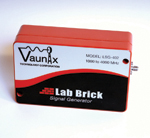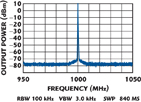
Signal generators have traditionally been amongst the most expensive pieces of test equipment found in RF and microwave test laboratories. Due to their high cost they are often in short supply and must be shared among multiple employees, between various test set-ups and sometimes even among multiple laboratories. This lack of equipment can result in delayed schedules, decreased productivity and, in the worst cases, can create unhealthy competition for resources among coworkers.
With this in mind, Vaunix Technology Corp. has introduced an innovative line of Lab Brick® signal generators. Covering 50 MHz to 6 GHz in four models, these devices deliver a true phase-locked RF signal with full output power control just like expensive, full sized RF signal generators, but at a fraction of the price. They are powered and controlled by a PC or laptop via any USB port. The Lab Brick graphical user interface (GUI) features intuitive controls with a large, uncluttered display making these devices simple to use. Lab Brick signal generators are a fast, easy and cost-effective solution to most signal generation needs.
Performance
Table 1 summarizes each model’s key performance specifications. The LSG-251 operates from 50 to 250 MHz, the LSG-152 operates from 250 to 1500 MHz, the LSG-402 operates from 1000 to 4000 MHz and the LSG-602 operates from 1500 to 6000 MHz. The output frequency resolution is 100 kHz with better than ±2 PPM initial accuracy. Each Lab Brick signal generator model is capable of producing +10 dBm of output power over its entire frequency range. The output power is adjustable in 0.5 dB steps over 55 dB of dynamic range.

Small Size
Lab Brick signal generators are enclosed in a rugged aluminum housing. Each unit measures just 4.90" x 3.14" x 1.59" and weighs less than one pound, making them ideal for bench top or rack mount use. Each housing features two external 0.25" diameter counter-bored through holes that can be used for mounting purposes. Device orientation does not affect performance.
Compliance
Lab Brick signal generators have been tested and comply with international EMC emissions and immunity requirements for Class A ISM devices. This insures that they will not interfere with nor will they be affected by other pieces of test equipment in close proximity. A copy of the compliance certificate can be viewed at the link provided at the end of this article.
Graphical User Interface
Figure 1 shows the Lab Brick signal generator’s graphical user interface. The GUI allows the operator to control the device by either keyboard or mouse. The user can enter parameter settings simply by typing directly into a specific parameter window. The GUI also features convenient up-/down-arrow keys for frequency and power control that allows the user to scroll through a range of settings using a mouse. The arrow step sizes can be adjusted by selecting from the standard increment soft-buttons or by selecting a user-defined value.

To further simplify operation every instance of an open GUI will display both the serial number and model number of the device to which it is coupled. Once the GUI has coupled with a specific Lab Brick signal generator, the GUI adapts to that device by tailoring the range of settings of the various operating parameters to those that are specific to that model number.
Device operating settings can be saved directly into the Lab Brick signal generator’s internal memory allowing the user to define the configuration of the device at power-up. The GUI also includes a comprehensive help function with guides to further resources for technical assistance.
Operation
Lab Brick signal generators are easy to use. Each unit is shipped with a 6’ USB cable and a thumb drive containing the GUI software and a soft copy of the user manual. Once the Lab Brick signal generator is plugged into a host computer or hub, the green LED on the side of the product will light up indicating that the device has been recognized by the host. When opened, or if the GUI is already running, it will automatically recognize the device and display both its model number and serial number. This instance of the GUI is now coupled to this Lab Brick signal generator. As additional Lab Brick signal generators are plugged into the USB and as additional instances of the GUI are opened, this coupling feature will automatically engage, allowing several Lab Brick signal generators to operate from a common host without confusion.

In continuous wave (CW) mode Lab Brick signal generators deliver a fixed frequency, sinusoidal signal. Figure 2 shows a measured phase noise plot of an LSG-152 model taken with the output frequency set to 1 GHz. Figure 3 further demonstrates spectral purity by showing the output spectrum over a 100 MHz span. Typically, its non-harmonic spurious content is below –80 dBc. The output power is adjustable from +10 to –45 dBm with 0.5 dB resolution. The output signal can also be completely turned off via the RF ON/OFF control buttons on the GUI.
In addition to the CW operating mode, each model has the ability to simulate a frequency sweep func- tion by stepping through a user-defined frequency band. In this mode the user also defines the frequency step size and the frequency dwell time. When used in conjunction with the “max/hold” function on a spectrum analyzer, this feature can be used to generate amplitude versus frequency response plots to characterize networks or devices. Figure 4 shows the amplitude characteristic of a ceramic bandpass filter having a center frequency of 2.81 GHz, a 3 dB bandwidth of 86.7 MHz and an insertion loss of 3.17 dB at the center frequency.

Compatibility
Lab Brick signal generators can be used with any PC or laptop having a USB 2.0 port. They can also be run from a powered USB 2.0 hub. Multiple Lab Brick signal generators can be run from a single host computer. Compatible operating systems include Windows 2000, Windows XP and Vista. A detailed programming guide is available upon request for those users who wish to integrate Lab Brick signal generators into existing ATE systems.
Conclusion

Due to their low cost and small size, Lab Brick signal generators eliminate the need for sharing and moving bulky pieces of equipment among laboratory coworkers. These rugged devices are also well suited for use on the manufacturing floor and in ATE systems. Their low price makes it an easy decision to integrate them into dedicated ATE and breadboard systems. They are even small enough to be brought on the road to support on-site service calls and product demonstrations. Additional information may be obtained by contacting the company via the company’s web site at www.labbrick.com
.Vaunix Technology Corp.
Haverhill, MA
(978) 662-7839
www.labbrick.com
RS No. 300
